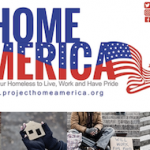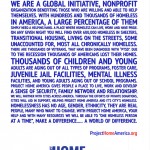Melver Lovette Robinson, a San Francisco native, retired in 2015 after working in hospitality, food services and for the Army for decades. She loved being around people and worked at the United Council of Human Services for 17 years — most recently, cooking meals for people experiencing homelessness. Back then, Robinson hadn’t expected she’d later become homeless herself. But the 64-year-old and her wife have been without a home for almost four years, most recently staying in a shelter.
Robinson flashes a big smile when she talks about her childhood: She was the eldest of seven children and both parents had steady jobs. As an adult, she spent time in prison for theft and drug use, but after that, she signed a lease with her wife and daughter, Candy. When Candy and her wife had a falling out, Robinson followed her partner onto the street. Research indicates that a growing number of people, like Robinson, are falling into homelessness during the period meant to be their golden years.
AMONG OLDER HOMELESS ADULTS, 44 PERCENT BECAME HOMELESS FOR THE FIRST TIME AFTER AGE 50, ACCORDING TO THE HOPE HOME STUDY OF THE BAY AREA’S HOMELESS POPULATION.
Researchers from the University of California at San Francisco (UCSF) interviewed 350 homeless adults aged 50 and older through population-based sampling in Oakland, California, over five years (the project has been renewed, ending in 2022). UCSF researchers estimate that half of the single homeless adults are age 50 or older, compared to 11 percent in the early 1990s — a 354 percent uptick. This data is emblematic of a graying homeless population across the nation: America’s homeless elderly population is projected to nearly triple by 2030, according to new research encompassing New York City, Boston and Los Angeles County. And this problem spans the globe: A 2017 report on the U.K.’s homeless population found that the population of homeless people over 60 had increased 111 percent since 2009, and for those over 75 it had increased by 155 percent — compared to an increase of 48 percent in the general population.
“This idea that older people are becoming homeless is … hard to reconcile when you’re not talking about the chronically homeless, or the drug user,” says Benjamin Henwood, a social work professor at the University of Southern California who specializes in homelessness. “This is a group of people who worked most of their lives, and are entitled to Medicare and benefits.”
This age cohort actually faced an elevated vulnerability for homelessness all their lives, says Margot Kushel, a UCSF professor of medicine who leads the HOPE HOME study. The second half of the baby-boomer generation entered the labor market during a 1970s recession. Their early adulthood coincided with the decline of unions, the Vietnam War, an era of mass incarceration and the war on drugs, Kushel says. At the same time, the federal government began to retreat from the affordable housing market: Today, the U.S. government spends roughly 30 percent of what it used to spend on subsidized affordable housing before the 1980s, she says.
Still, historical risk factors alone don’t explain late homelessness. Only 16 percent of HOPE HOME’s participants who became homeless after age 50 had degrees higher than high school diplomas, and 63 percent worked unskilled or semi-skilled jobs. Many had physically demanding, low-paying jobs without robust benefits. “They spent their whole careers kind of hanging on by their fingernails,” Kushel says. Saving for retirement wasn’t feasible for those like Robinson, who worked two jobs while living paycheck to paycheck. And lack of quality health care, poor nutrition and insufficient time for sleep increased physical vulnerability.
Kushel says many participants spoke about some destabilizing event after age 50. People’s bodies gave out, leaving them unable to do physical labor. A job got outsourced and they were less competitive in the market. A partner lost his or her income, or a parent with whom they lived died. Even so, there’s no single overarching narrative for these experiences, notes Kenneth Perez, a clinical research coordinator for the HOPE HOME study.
Nationally, homelessness has been rising since 2017 following years of decline, according to the 2018 Annual Homeless Assessment Report. These new waves are outweighing successful efforts to reduce chronic homelessness through interventions like Permanent Supportive Housing and the Housing First model, Kushel says. What’s more, the physical strain of living on the streets can cause people in their 50s to display geriatric conditions typical of those in their 70s and 80s. Henwood suggests that may require shifting care models from “homeless services” to “aging programs” with staff equipped to handle conditions like dementia. Today’s shelters and permanent supportive housing weren’t designed for an aging population, says Claudia Ponath, a project manager for the UCSF study.
“Unless and until we’re prepared to accept the fact that we’re going to have large numbers of people in their 50s, 60s and 70s living and dying on our streets, we need to act,” Kushel says. What’s more, this issue could touch anyone, though it disproportionately affects minorities — and defies what we think should happen in people’s golden years, Henwood says. Nobody would tell 72-year-olds that they only deserve housing if they get back to work, Perez says. From a taxpayer standpoint, he notes that homelessness prevention is far less costly than interventions, just as disease prevention is cheaper than dealing with late-form illness.
Robinson, for one, says she’s at peace with her situation. The adjustment to homelessness was difficult, but she’s endured her fair share of hardships over her lifetime. The shelter is helping her and her wife find housing, which they expect to move into next month. Her puppy will have room to run around, and Candy will come by to see the place. “I’m not better than nobody,” Robinson says, “but I want better.”







